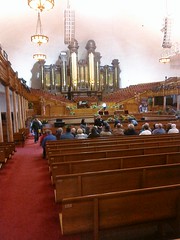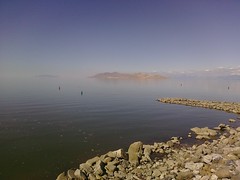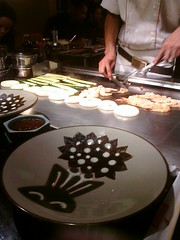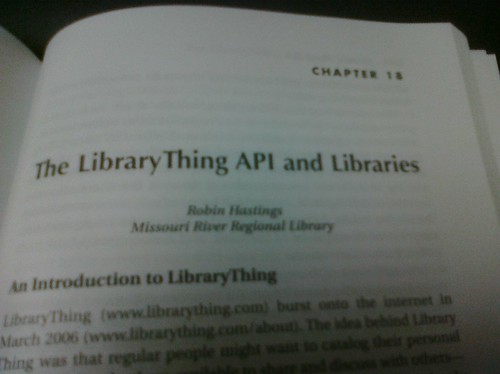After a truly fabulous “continental” breakfast which included an egg & bacon sandwich and a breakfast burrito (thanks, LITA!!), I went back to my room to pack. Now that all that is done, I’m in the ballroom, waiting for the closing keynote by Liz Lawley,of the RIT Lab for Social Computing. I’ve seen her give this talk before, at Internet Librarian, but I’ve heard this is an updated version, so I’m all ears!
The session title is Technical/Tangible/Social. She’ll be talking about a city-wide game (in conjunction with her local newspaper) as well as her traditional tech/tang/social presentation. She started with a quote that starts: “One day we will look back with embarrassment on this era when all of our virtual experiences are locked behind a screen”. She mentioned a USB doll that stands up when an IM buddy logs on, then falls down when they log off and the botanicalls product, which tweets when your plants need to be watered. She then showed pics of Make: and Craft: – I’d not seen the Craft: magazine… – both are put out by O’Reilly, the programming books publisher.
She mentioned Ravelry!!!! So cool – “object-oriented sociality”, you can do some amazing pivot searches – look up the yarn that you just bought on sale, limit to just knitting projects, limit to just type of garment… etc.
Next was Moo cards – nice because they are quality – they feel good to hold.
Go to where they are – not a good idea; make a place where they want to be. (not sure I agree with this, I still think it’s a good idea to get out there and be accessible)
Next she goes to the talk “Picture the Impossible: A technical, tangible, social game”. An alternate reality game – but calling it a city-based adventure game. “It’s non-trivial to come up with a plan for a game of this magnitude.”
Missions: learn the history of the city; explore the city itself; give something back to the community; socialize
“What are the verbs associated with your game?” -excellent question and a good way to combat scope creep.
Looked at places to go (public market in Rochester), looked at (and tied into) events that were happening during the game, included a big party at the end.
They did this with a $0 budget; created a narrative involving a secret society that was splintered into 3 factions (game players choose a faction; their points go toward that faction) and at the end of the game, that society would throw a party for those who completed the game (needed to get an invite to this exclusive party). They picked 3 local charities to involve in the game as well.
Making players choose the faction immediately makes them more invested in the game (WoW’s character/faction choice, etc.). They created a theme per week (7 weeks, with the celebration on the 31st of Oct.).
She did get some small amounts from newspaper and college with a bit more from MS to use Bing’s mapping features during the Bing launch.
Lesson learned: really clarify authority & responsibility before heading off to work on this kind of thing.
Picture The Impossible launch trailer – YouTube
Launched on Sept. 12 with 800 pre-registered.
She’s been spending the last 10 minutes or so showing us the games and such and it’s completely fascinating…
2000+ fully registered players (valid phone or facebook connect account). Many of the most active players are women and mothers.
She hopes that the model will be replicated elsewhere – especially in public libraries.
At that point, she finished and I have to run to check out of my room.
Category: Web 2.0
LITA Forum – presenter edition
So, today I presented my “Collaborating In The Cloud” session at LITA. It went well – lots of questions about a number of different things, but, as always it seems, a lot of the discussion was happening on Twitter. One of the things that came up, both as an in-person question and as a Twitter topic, was the separation of work and personal in social networks. I mentioned in my presentation that I got a lot of pushback when I asked, back in my researching for the LTR days, about people using Facebook for work purposes. Many respondents said that Facebook was for fun and that they weren’t going to use it for work. Period.
That started a discussion about separating the work part of what you do on Facebook from the personal stuff. Groups are always an option, but one of the Tweeters, Maureen Kearny (mosylu) expressed a concern about leakage from your professional groups to your personal groups. I have to agree that it is something to be concerned about.
Creating groups in Facebook is pretty easy, but not particularly intuitive. The steps are:
- Hover over the “Friends” link toward the left top side of the page
- Click on All Friends
- Click “Create new list”
- Type in the name of your list and select people to add to it; click Create List
- Hover over the “Settings” link at the top right of your Facebook page
- Click on “Privacy Settings” after it drops down
- Click “Profile”
- Click drop-down list on each section listed on the page – all (except the general “Profile”) allow you to make things visible to all of your friends *except* whoever is in one of your lists
- Rinse, lather, repeat until you have locked down your profile
- Go To Applications Settings (also off of the Settings link at top right)
- Edit any work-related apps to be visible only to work-related lists
This requires some thought, perhaps a bit of pre-planning (who goes into what list?) and some time to do right, but it is not too complicated to make it happen. It is also the only really legal way to do it – Facebook frowns on people who create personal and professional accounts… Of course, now that LinkedIn offers applications such as the Huddle Workspace app, maybe using that instead of Facebook would be better for you.
While Facebook is huge, and everyone (it seems) has an account, it’s not the only game out there. It may be the easiest in terms of learning curves (as in, people have already climbed that particular curve, not that it doesn’t exist) and passwords (oh no – not ANOTHER site that I have to maintain a user/pass combination for…), but if you are concerned about mingling your personal and your professional, learning a new application and keeping track of yet another password may be worth it to you. This is one of the benefits of choosing cloud collaboration – you have options!!
Lightning Talks – session 3
Maurice York from NCSU started us off with Ther I Fix’d It – the ILS undone in 3 easy steps. He’s going through a rather amusing history of the ILS from card catalog to automation. Now he’s packing in journals and links and ejournals and discovering that it’s hard to manage. He’s adding bits and pieces and secondary (and tertiary) systems until they are out of control. Step 1 – campus is buying stuff, get rid of acquisitions module (more academic library stuff..) Step 2 – get serials out Step 3 – get rid of all the other electronic stuff, too. There. He fixed it.
Next is Jacquelyn Erdman talking about design as strategy, not decoration. Be able to come up with something crisp, clean and that will communicate 4 tips:
- Choose your graphics carefully – only add things that are required for the message
- Choose your font wisely – this is your voice
- Get help in selecting colors – www.colormatters.com/colortheory.html – steal colors others have come up with
- Use Templates – use color libraries in Photoshop
Note: looks like the guy who was going to do Google Squared didn’t show – I’m sad…
Marilyn Billings talked about ESENCe – an example of partnering with Faculty to pull in large grants. Lots of academic library stuff that really doesn’t apply to me yet. I’ll let you know when she says something I find useful as a public library type.
Next up was Tate Nunely of Ex Libris talking about Digital Perils and Preservation. He began with stats – the growth of digital content – up to 988 exabytes by Jan 2010. He did a case study for digital preservation – the NASA Mars data, by the time they went back to look at it, the digital info was degraded – only 10% was usable. Challenges:
- Deterioration
- Obsolescence
- Failure to document the data
- one more that I missed…
Preservation should not be what we “should do”, but what we “should be doing right now”. Take a look at what you are preserving occasionally – make sure you have what you think you have in a format you can still access.
Finally, Mark Beatty spoke about creating your own sandbox with Bitami. www.bitnami.org try out an open source system (drupal, linux, wordpress, etc) in an easy way with a Bitnami stack (everything installs in a protected way). You can do it locally or in the cloud using Amazon’s Ec2 – they already have Bitnami stacks ready to go. Ohhh – they have a RubyStack. I’m going to have to play with that… Advice – pay attention to where it’s being installed so that you can add modules and themes and such.
Oh – there is a surprise talk by Cody from the University of Minnesota. lib.umn.edu/mobile – their mobile site. We’re gonna get a tour!! 2 search boxes – search Primo installation or classic version or search scholarly databases. Records indicate book, availability, location and then “get it” (paging and delivery service) only – very pared down for mobile users.
Now for questions & answers. I’m getting nervous about my battery life, though, so I’ll hit publish…
Yes, it is odd to have the opening keynote after the first session, but that first session was only offered to LITA’s speakers, so it was scheduled oddly… Anyway, Joan Lippencott is going to speak on the topic of mobile tech in libraries.
First, though Andrew Pace pointed out the Twitter hashtag (#litaforum) and the Flickr pics at Pix4Lita. Then he introduced all the amazing folks who had something to do with the conference, finishing with an introduction of Joan.
Joan introduced the CNI (Coalition for Networked Information), where she works, then went into stats on just how mobile our world is… 80.5% of college students own laptops, 66% of college students own an Internet-capable cell phone. She followed up with info for e-book readers – Kindle sales of Dan Brown’s Lost Symbol topped print sales for a short time. She mentioned Twitter taking off (note – I’m tweeting while live blogging, so if I make no sense, cut me some slack) and mainstream press moving to mobile applications (saw somewhere that CNN is #1 paid app for iPhone?).
Will libraries meet the challenges of mobile world? Mobile-enabled content, mobile-enabled services, promotion of content are all important.
Understanding Users
“Smartphones moving from communication devices to information devices”. Kid’s consider mobile phones to be their “best friend” – they would keep those over desktop computers, game consoles and MP3 players. 67% of students in 9-12 grades maintain a personal website – and they want to use their own devices (phones, laptops, etc) in learning. Don’t make assumptions about what your users have/want – find “Informing Innovation” includes survey to get info from your users
Mobile Libraries
Typical – hours/catalog/etc. or SMS reference
Could be:
- library general info
- patron records
- reference transactions
- info literacy podcasts & videos
- access to services (booking group rooms)
- finding open computers
- access to catalogs, indexes, abstracts
- access to mobile-configured content (owned by library or free on the web)
- geospatially linked information (Google maps, etc.)
- loan of devices
University of Virginia – Library Mobile site; brings a bunch of mobile services together.
arXiv for the iPhone – preprint site in high energy physics (freely available on the web – we should be linking to this if it fits our audience)
Mobile-accessible resources
- World Cat Local
- Google Book Search Mobile
- Refworks Mobile
- Blackboard
- Audiobooks
- IEEE Xplore database
- J Americal Chemical Society (beta)
- iTunes U (we, as a public library, should be linking to this, definitely!)
- Podcasts from research & education institutions
QR codes – some smart phones contain QR code reader in them.
Uses: on books to go to online discussion about that book, on reference desk (after hours) linking to common reference questions, etc.
Services via Twitter
Arizona State U. Library Channel – good promotion of services. Also showed a paper poster explaining (graphically) what services the library offers (tech loaning services, etc) both in and outside the library.
Now is the time to create a full-fledged strategy for “mobile revolution”.
Point made during Q&A – if you participate in World Cat, you have mobile access to your catalog (and someone else mentioned that you can create your own interface to World Cat). Nifty – I hadn’t thought of it that way!
Salt Lake City – Tourist Edition
 This morning I was up super-early, so I messed around in my room for a while, went down and got some coffee & banana bread for breakfast, then messed around online for a bit, before heading out to the Temple Square at just after 8am. I wandered the area until 9am, when the visitor center opened, then went in (out of the cold – it’s chilly out there!) and did a tour of the visitor center with a very nice, very earnest older man who made the term proselytizing seem tame… After that, I wandered farther through the square, taking a bunch of pictures, most of which seemed to be eaten by my phone on the way to Flickr, apparently, then stopped by the Beehive House. If any of you have read the 19th Wife, you will understand why I wanted to definitely hit this while I was here! I took the tour and noticed that they kept referring to Brigham’s first wife, but never once mentioned the other wives who lived in the house as well. It was an interesting tour, though – the house is gorgeous!
This morning I was up super-early, so I messed around in my room for a while, went down and got some coffee & banana bread for breakfast, then messed around online for a bit, before heading out to the Temple Square at just after 8am. I wandered the area until 9am, when the visitor center opened, then went in (out of the cold – it’s chilly out there!) and did a tour of the visitor center with a very nice, very earnest older man who made the term proselytizing seem tame… After that, I wandered farther through the square, taking a bunch of pictures, most of which seemed to be eaten by my phone on the way to Flickr, apparently, then stopped by the Beehive House. If any of you have read the 19th Wife, you will understand why I wanted to definitely hit this while I was here! I took the tour and noticed that they kept referring to Brigham’s first wife, but never once mentioned the other wives who lived in the house as well. It was an interesting tour, though – the house is gorgeous!
 After that I wandered the downtown area – mostly because I was sort of lost and was having trouble finding the street my hotel is on. Turns out I was heading the right direction, just needed to go a bit farther, since I had completely underestimated how long the Temple Square actually is.
After that I wandered the downtown area – mostly because I was sort of lost and was having trouble finding the street my hotel is on. Turns out I was heading the right direction, just needed to go a bit farther, since I had completely underestimated how long the Temple Square actually is.
Then, after lunch and an hour’s nap, I hopped on a tour bus and headed to the Great Salt Lake. While there, we saw the old Saltair pavilion, where the Insane Clown Posse was getting ready for a concert this evening. Beyond that was the GSL Marina, where we stuck our fingers in the water, viewed some brine shrimp in a cup and saw the results of letting GSL water evaporate from a glass jar (the evaporation already happened – we didn’t have to wait around for it).  The bus ride back was uneventful and there was another period of resting in my room before I headed out to a nearby Benihana’s for dinner. The meal was excellent (Seafood Diablo – spicy!) but the service was iffy. The red wine, sake and plum wine sangria I had with my meal, however, ensured that I wasn’t that bothered by it.
The bus ride back was uneventful and there was another period of resting in my room before I headed out to a nearby Benihana’s for dinner. The meal was excellent (Seafood Diablo – spicy!) but the service was iffy. The red wine, sake and plum wine sangria I had with my meal, however, ensured that I wasn’t that bothered by it.
In Salt Lake City
I have landed in Salt Lake City, in preparation for the LITA Forum, and have managed to find my hotel room, a Starbucks and a brew pub all within the first 10 minutes of my arrival. I rock. Anyway, the flight in, once we descended from the clouds, was incredible. The view from the plane was of immense mountains, their peaks sticking holes in the cloud cover, ringing the valley in which Salt Lake City sits. It was gorgeous. My first few minutes on the ground, not so much. Lots of clouds completely obscuring those mountains and threatening rain all around the city (but none in the city proper, yet).
The drive in was interesting – Salt Lake is a pretty cool looking town. I saw a drive through Sushi place and billboards for at least a couple of local breweries. Then, just as we were turning into the Hilton’s drive, I saw a brew pub that was directly across the street from the hotel. I may try eating there tonight – depends on the rain situation.
It’s cold here – 45 degrees, cloudy and windy when we landed – but the weather should improve about the time the main conference starts and I’m relegated to inside rooms all the time…
The hotel, what I’ve seen of it (the registration desk, the Starbucks and my room, so far) is lovely. They gave me a complimentary code for Internet access (from the conference or the hotel? I’m not sure!) and made the trip a bit cheaper for me!! I can’t live without my Internet!!!
Tomorrow is sightseeing day. Prepare to be inundated with lots of pictures! Friday the main conference starts, Saturday is my program, Sunday is the end of the conference and my flight home. I’ll post more later!!
The week in Tweets
- I introduced my Mom (and her new netbook) to Evernote last night. She now thinks I'm a genius , cause she can store her recipes properly! #
Powered by Twitter Tools
The week in Tweets
- forcing myself not to go to Amazon and order the Lost Symbol on my Kindle. Reviews are making it hard, though. Send "be strong" vibes, plz!! #
- Listening to "a flock of 80s" radio station via my Palm #Pre – Elton John ftw! #
- JazzFest @ park 2 blocks away makes nice bkgd music 4 my backyard reading this afternoon! #
Powered by Twitter Tools
The week in Tweets
- I just had to make an emergency run to the golf course so Alex could get to his tee time. When did I become a golf mom? #
- My chapter – the first couple of lines or so at least [pic] http://ff.im/7UYOc #
- just spent 10 minutes with Nikki's 5 month old baby – so very cute, still don't want another one of my own. #
- Peanut butter jelly time!! [pic] http://ff.im/7XJay #
- 2 1/2 blocks of a log cabin baby blanket [pic] http://ff.im/83dsG #
Powered by Twitter Tools
Library Mashups book
My author copy of Library Mashups came today!! Here, below, is a camera-phone image of the header of the chapter I wrote for the book (Chapter 18: The LibraryThing API and Libraries). Wanna see more? Buy it!!
